Exotic, but established
Acleris comariana (Lienig & Zeller) (Tortricidae: Tortricinae: Tortricini)
Common names: strawberry tortrix
Synonyms: baracola (Acalla), burnneana (ab.), comparana (ab.), fasciana (ab.), fuscana (ab.), latifasciana (ab.), meincki (Acalla), potentillana (ab.), proteana (ab.)
FWLFWL:
forewing length; the distance from the base of the forewing to the apex, including fringe : 5.0-8.5 mm
: 5.0-8.5 mm
Seven forms or aberrations have been described, many of which are identical in appearance to other Acleris species such as A. laterana (Fabricus) and A. extensana (Walker). Wing pattern among the different forms varies considerably, but all have a dark triangular costal patch which ranges in color from black to brown to red. Males lack a forewing costal foldforewing costal fold:
a flap or fold at the base of the forewing that contains specialized sex scales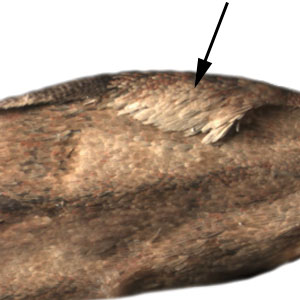 .
.
The general form of the male genitalia is sufficient to place individuals in the A. comariana/laterana complex. Female genitalia are less diagnostic but A. comariana has a much-reduced signumsignum:
a sclerotized projection or patch on the interior of the corpus bursae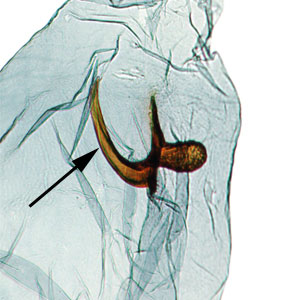 .
.
The following account is summarized from Petherbridge (1920)Petherbridge (1920):
Petherbridge, F. R. 1920. The life history of the Strawberry Tortrix, Oxygrapha comariana (Zeller). Annals of Applied Biology. 7: 6-10. and Turner (1968)Turner (1968):
Turner, J. R. G. 1968. The ecological genetics of Acleris comariana (Zeller) (Lepidoptera: Tortricidae), a pest of strawberry. Journal of Animal Ecology. 37: 489-520..
Early instar larvae are white with a black head, prothoracic shieldprothoracic shield:
a sclerotized plate on the dorsal surface of the prothorax 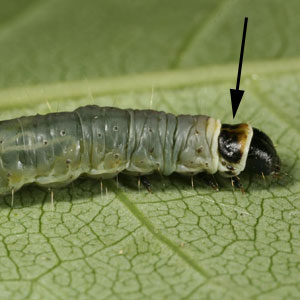 , and legs. Abdomen color varies in later instars, but all have a darker subdorsal line and conspicuous brown pinaculapinaculum:
, and legs. Abdomen color varies in later instars, but all have a darker subdorsal line and conspicuous brown pinaculapinaculum:
flattened sclerotized plates on a caterpillar that bear the setae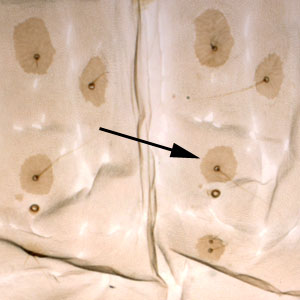 . The head is yellowish brown along with the prothoracic shieldprothoracic shield:
. The head is yellowish brown along with the prothoracic shieldprothoracic shield:
a sclerotized plate on the dorsal surface of the prothorax  , which has a dark brown or black posteriorposterior:
, which has a dark brown or black posteriorposterior:
after, to the rear, toward anal end 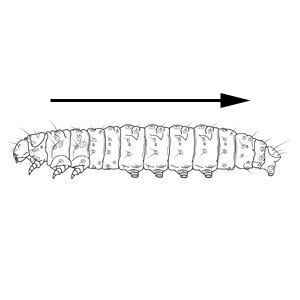 margin. Larvae of A. laterana can be distinguished from A. comariana by the dark brown to black posteriorposterior:
margin. Larvae of A. laterana can be distinguished from A. comariana by the dark brown to black posteriorposterior:
after, to the rear, toward anal end  margin of the prothoracic shieldprothoracic shield:
margin of the prothoracic shieldprothoracic shield:
a sclerotized plate on the dorsal surface of the prothorax  , which has two subdorsal spots in A. laterana, and brown pinaculapinaculum:
, which has two subdorsal spots in A. laterana, and brown pinaculapinaculum:
flattened sclerotized plates on a caterpillar that bear the setae with are concolorous with the abdomen and not conspicuous in A. laterana. Acleris laterana has not been recorded from North America.
with are concolorous with the abdomen and not conspicuous in A. laterana. Acleris laterana has not been recorded from North America.
Acleris comariana is most closely related to the European A. laterana, which is referred to by the synonym A. latifasciana in many publications. Because Sheldon (1925)Sheldon (1925):
Sheldon, W. G. 1925. Peronea comariana Zeller, and its variation. Entomologist. 58: 281-285. described many of the A. comariana forms using names identical to Acleris species names, literature discussions of differences in species and forms must be carefully followed to avoid confusion. Acleris laterana is not known to occur in North America.
Razowski (2002) illustrates differences in genitalia that can be used to separate A. comariana from other closely related European Acleris.
The following account is summarized from Petherbridge (1920)Petherbridge (1920):
Petherbridge, F. R. 1920. The life history of the Strawberry Tortrix, Oxygrapha comariana (Zeller). Annals of Applied Biology. 7: 6-10. and Turner (1968)Turner (1968):
Turner, J. R. G. 1968. The ecological genetics of Acleris comariana (Zeller) (Lepidoptera: Tortricidae), a pest of strawberry. Journal of Animal Ecology. 37: 489-520..
Acleris comariana completes two generations in Europe, with adults present from mid-June to July and again from late August to early November. It prefers wetlands and bogs where many of its host plants occur. Females deposit eggs on lower parts of the plant, usually on the stipules or petioles. Eggs from the first generation hatch in approximately 10 days; those of the second generation turn a reddish color and hatch the following spring. Larvae feed inside tied or folded leaves although they may also feed on flowers of some hosts. In strawberry, flower-feeding causes distortion of fruit or prevents it from developing. Pupation occurs in a cocoon that is constructed in a rolled leaf or between the stem and petioles.
Acleris comariana feeds on a variety of plants in the family Rosaceae. Records of A. laterana (= latifasciana) on Rhododendron L. from continental Europe are thought to refer to A. comariana.
| Host plant | Host plant family | Reference(s) |
| Rhododendron sp. (as "Azalea") | Ericaceae | Bradley et al. 1973Bradley et al. 1973: Bradley, J. D., Tremewan, W. G., Smith, A. 1973. British Tortricoid Moths, Cochylidae and Tortricidae: Tortricinae. The Ray Society, London. 251 pp. |
| Comarum sp. | Rosaceae | Benander 1965Benander 1965: Benander, P. 1965. Notes on the larvae of Swedish Micro-Lepidoptera. II. Opusc. Ent. 30: 1-23.; Dugdale et al. 2005 |
| Crataegus sp. | Rosaceae | Yasuda 1975Yasuda 1975: Yasuda, T. 1975. The Tortricinae and Sparganothinae of Japan (Lepidoptera: Tortricidae). Part II. Bulletin of the University of Osaka Prefecture, Series B. 27: 79-251. |
| Fragaria sp. | Rosaceae | Meyrick MS 1938Meyrick MS 1938: Meyrick MS 1938. Unpublished manuscript by E. Meyrick at BMNH, data captured by Gaeden Robinson.; Bradley et al. 1973Bradley et al. 1973: Bradley, J. D., Tremewan, W. G., Smith, A. 1973. British Tortricoid Moths, Cochylidae and Tortricidae: Tortricinae. The Ray Society, London. 251 pp.; Dugdale et al. 2005Dugdale et al. 2005: Dugdale, J. S., Gleeson, D., Clunie, L. H., Holder, P. W. 2005. A diagnostic guide to Tortricidae encountered in field surveys and quarantine inspections in New Zealand: Morphological and molecular characters. National Plant Pest Reference Laboratory. 161 pp. |
| Fragaria vesca | Rosaceae | Bradley et al. 1973Bradley et al. 1973: Bradley, J. D., Tremewan, W. G., Smith, A. 1973. British Tortricoid Moths, Cochylidae and Tortricidae: Tortricinae. The Ray Society, London. 251 pp. |
| Geum rivale | Rosaceae | Bradley et al. 1973Bradley et al. 1973: Bradley, J. D., Tremewan, W. G., Smith, A. 1973. British Tortricoid Moths, Cochylidae and Tortricidae: Tortricinae. The Ray Society, London. 251 pp. |
| Geum sp. | Rosaceae | Dugdale et al. 2005Dugdale et al. 2005: Dugdale, J. S., Gleeson, D., Clunie, L. H., Holder, P. W. 2005. A diagnostic guide to Tortricidae encountered in field surveys and quarantine inspections in New Zealand: Morphological and molecular characters. National Plant Pest Reference Laboratory. 161 pp. |
| Malus pumila | Rosaceae | Yasuda 1975Yasuda 1975: Yasuda, T. 1975. The Tortricinae and Sparganothinae of Japan (Lepidoptera: Tortricidae). Part II. Bulletin of the University of Osaka Prefecture, Series B. 27: 79-251. |
| Malus toringo | Rosaceae | Yasuda 1975Yasuda 1975: Yasuda, T. 1975. The Tortricinae and Sparganothinae of Japan (Lepidoptera: Tortricidae). Part II. Bulletin of the University of Osaka Prefecture, Series B. 27: 79-251. |
| Potentilla palustris | Rosaceae | Bradley et al. 1973Bradley et al. 1973: Bradley, J. D., Tremewan, W. G., Smith, A. 1973. British Tortricoid Moths, Cochylidae and Tortricidae: Tortricinae. The Ray Society, London. 251 pp. |
| Potentilla sp. | Rosaceae | Meyrick MS 1938Meyrick MS 1938: Meyrick MS 1938. Unpublished manuscript by E. Meyrick at BMNH, data captured by Gaeden Robinson.; Dugdale et al. 2005Dugdale et al. 2005: Dugdale, J. S., Gleeson, D., Clunie, L. H., Holder, P. W. 2005. A diagnostic guide to Tortricidae encountered in field surveys and quarantine inspections in New Zealand: Morphological and molecular characters. National Plant Pest Reference Laboratory. 161 pp. |
View full screen host table here
In the Palearctic, A. comariana is widely distributed across Europe to China and Japan. In North America, it is present in the Pacific Northwest, where it was first identified in British Columbia in 1972 (Cram 1973Cram 1973:
Cram, W. T. 1973. Occurrence of the strawberry tortrix, Acleris comariana (Zeller), a new pest in British Columbia (Lepidoptera: Tortricidae). Journal of the Entomological Society of British Columbia. 70: 17.). Reports from Washington require confirmation. A similar species previously identified as A. comariana in eastern North America likely represents an undescribed, cryptic species (Gilligan et al. 2020bGilligan et al. 2020b:
Gilligan T. M., Brown, J. W., Baixeras, J. 2020b. Immigrant Tortricidae: Holarctic versus Introduced Species in North America. Insects. 11(9): 1-59.). Acleris comariana has also been introduced to New Zealand.